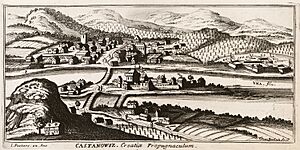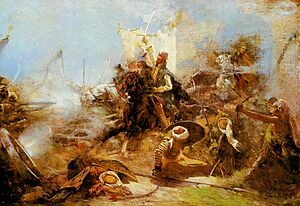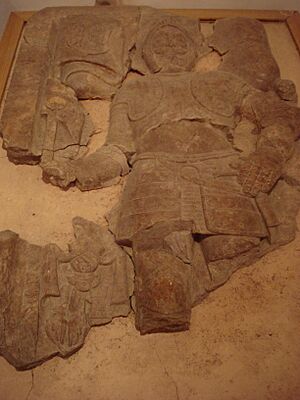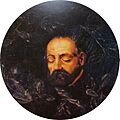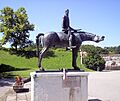Nikola IV Zrinski facts for kids
Quick facts for kids
Nikola IV Zrinski
Miklós IV Zrínyi |
|
|---|---|
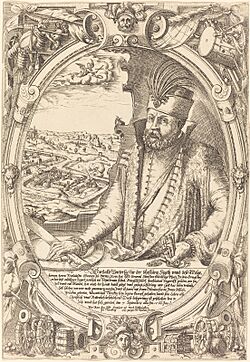
A 16th-century engraving by Matthias Zündt
|
|
| Ban (Viceroy) of Croatia | |
| In office 24 December 1542 – 7 September 1556 |
|
| Preceded by | Petar Keglević |
| Succeeded by | Péter Erdődy |
| Personal details | |
| Born | circa 1508 Zrin, Kingdom of Croatia |
| Died | 7 September 1566 (circa 58) Szigetvár, Kingdom of Hungary |
| Resting place | Pauline monastery in Sveta Jelena, Croatia |
| Spouses | Katarina Frankopan Eva Rosenberg |
| Children | Ivan II, Jelena, Katarina, Juraj IV, Doroteja, Uršula, Barbara, Margareta, Magdalena, Ana, Kristofor, Nikola V, Ivan III |
| Parents | Nikola III Zrinski Jelena Karlović |
| Signature | |
| Military service | |
| Battles/wars | Siege of Vienna (1529) Siege of Pest (1542) Battle of Babócsa (1556) Battle of Moslavina (1562) Siege of Szigetvár (1566) |
Nikola IV Zrinski (also known as Nikola Šubić Zrinski) was a brave Croatian nobleman and general. He was the Ban (or Viceroy) of Croatia from 1542 to 1556. His family, the Zrinskis, became very powerful in the Kingdom of Croatia during his time.
He became famous across Europe for his heroic stand at the Siege of Szigetvár in 1566. There, he died fighting to stop the Ottoman Empire's Sultan Suleiman the Magnificent from advancing towards Vienna. This battle was so important that a French leader, Cardinal Richelieu, called it "the battle that saved civilization." Nikola Zrinski is remembered as a loyal and brave warrior. He is a national hero in both Croatia and Hungary.
Contents
Early Life and Family Beginnings
Nikola was a Croat. He was born around 1508, likely at Zrin Castle. He was one of six children. His father was Nikola III Zrinski, and his mother was Jelena Karlović. Jelena was the sister of Ivan Karlović, who would also become a Croatian Ban.
Nikola's Military Actions
Nikola Zrinski first showed his bravery during the Siege of Vienna in 1529. He was only in his early twenties. For his actions, he received a horse and a golden chain.
After his father died in 1534, Nikola and his older brother Ivan inherited their family lands. They began to strengthen their forts. They also fought against the Ottomans who attacked their lands.
Fighting the Ottomans
In 1539, Zrinski killed Johann Katzianer, an Imperial Army commander. Katzianer had betrayed King Ferdinand I. The next year, Ottoman forces attacked the Zrinski lands again. Despite little help from the Austrian military, Zrinski and his brother fought bravely. They lost the fortress of Kostajnica for a short time. However, Zrin Castle and Gvozdansko Castle held strong. From then on, the Zrinski family constantly fought against the Ottomans.
Becoming Ban of Croatia
In 1541, King Ferdinand I gave Nikola and his brother Ivan large estates. When Ivan died that same year, Nikola became the sole heir to the Zrinski family lands. In 1542, he helped save the Imperial Army at the Siege of Pest. For this service, he was named Ban of Croatia. He held this important position until 1556.
During this time, he often visited Gvozdansko Castle to check on the silver mines. In 1546, King Ferdinand I gave him the entire region of Međimurje. This made the city of Čakovec the new center of the Zrinski family. Nikola greatly improved the Čakovec Castle.
Later Military and Political Roles
In 1556, Zrinski won several battles against the Ottomans. He stopped them from taking Szigetvár. However, he felt he did not have enough resources for defense. So, he stepped down as Ban of Croatia.
The next year, in 1557, he became the Master of the treasury. This was a high royal office, making him one of the most important people in the Kingdom of Hungary. He also served as a captain of Croatian cavalry and commander of the Transdanubian border.
In 1563, Zrinski attended the coronation of Emperor Maximilian as King of Hungary. He led 3,000 Croatian and Hungarian noblemen. He hoped to become the Palatine, another very high position. Some historians believe he did achieve this. In 1564, he defeated the Ottomans at Szeged.
The Heroic Stand at Szigetvár
In the spring of 1566, Zrinski was at Szigetvár. This fortress was key to defending the shortest route to Vienna. The Ottoman Sultan Suleiman the Magnificent planned to attack Vienna again. But first, he decided to capture Szigetvár.
King Maximilian II told Zrinski he could leave the fortress. But Zrinski wrote a letter on April 23rd saying he would stay. He knew many thousands of people depended on the fortress's survival. He began to prepare for the Sultan's attack.
Suleiman's army reached Belgrade on June 27th. When Suleiman heard that Zrinski had attacked Turkish forces at Siklós, he changed his plans. He decided to attack Szigetvár first to remove Zrinski as a threat.
From August 5th to September 7th, Zrinski and about 2,300-2,500 soldiers, mostly Croats, defended Szigetvár. They faced an Ottoman army of over 100,000 soldiers and 300 cannons, led by Sultan Suleiman himself. They fought without the reinforcements that the King had promised. Zrinski even refused Suleiman's offer of Croatian land.
The siege ended on September 7, 1566. Zrinski led his remaining soldiers in a desperate charge out of the fortress. All of them died heroically. Sultan Suleiman also died, but from natural causes, one day before the Ottomans won the siege. The Ottoman army had suffered heavy losses. They only managed to capture the nearby fort of Babócsa before ending their conquest.
Zrinski's Final Moments
Historical accounts say that Zrinski chose to wear a hat and a nice suit, not a helmet and armor, for his final charge. He carried his father's sabre. He wanted it to be known that he faced God's judgment fully. He even offered a reward to the Ottoman soldier who would cut off his head. A Janissary killed him with a musket. His body's exact fate is unknown, but it might have been buried by a former Muslim captive named Mustafa Vilić, whom Zrinski had treated well.
In the Međimurje County Museum in Čakovec, parts of a tombstone believed to belong to Nikola IV are kept. His head was likely buried there. In the Kunsthistorisches Museum in Vienna, you can see Zrinski's sabre, helmet, and possibly a silk robe. These items were worn by him during Maximilian II's coronation in 1563.
Nikola's Marriages and Children
Zrinski married twice. First, in 1543, he married Katarina Frankopan. After she died in 1561, he married Eva Rosenberg in 1564.
His marriage to Katarina Frankopan brought him many lands, including Ozalj. His marriage to Eva Rosenberg connected him to a powerful Czech noble family. These marriages and his service helped the Zrinski family become the most powerful noble family in Croatia.
His Children
Nikola had thirteen children with Katarina and Eva. His most notable child was his successor, Juraj IV Zrinski. His daughters also married into important noble families, which further strengthened the Zrinski family's connections.
Nikola Zrinski's Lasting Legacy
Nikola Zrinski's heroic actions at Szigetvár made him a famous European Christian hero. He was seen as a defender of Christendom. People even compared him to Leonidas I, the Spartan king. His story of heroism was especially important in Croatia, Hungary, and Slovakia. In Croatia, he became a symbol of Croatian identity.
Historians describe Zrinski as having "exceptional military talent." He was also a successful businessman and a smart politician.
How He Is Remembered
His story was first told in a report called Podsjedanje i osvojenje Sigeta (1568) by his scribe, Franjo Črnko. This report was quickly translated into many languages.
Later, his great-grandson, Nikola VII Zrinski, wrote a famous Hungarian epic poem called The Siege of Sziget (1651). This poem made the elder Zrinski a lasting hero in Hungarian culture. There was also a Croatian version of the poem.
In the 18th century, school plays were made about his heroic act. The German writer Theodor Körner wrote a play called Zriny: Ein Trauerspiel (1812). The Croatian composer Ivan Zajc created a famous opera titled Nikola Šubić Zrinski (1876). This opera is still performed regularly today. It includes a well-known song, "U boj, u boj" (To Battle, To Battle), which is even performed in Japan!
Art and Memorials
Since the 16th century, Zrinski has appeared in many artworks. These include engravings and paintings, showing him in portraits or leading the charge at Szigetvár. Famous artists like Alphonse Mucha dedicated paintings to him.

In 1863, Emperor Franz Joseph I of Austria honored Zrinski. He was added to a list of "Austria's most famous warlords." A life-size statue of him was built at the Museum of Military History, Vienna in 1865.
You can find many sculptures and busts of Zrinski in cities like Zagreb, Čakovec, Budapest, and Szigetvár. Parks in Zagreb (like Nikola Šubić Zrinski Square), Koprivnica, and Križevci are named after him.
In 2016, Croatia and Hungary marked the 450th anniversary of the Siege of Szigetvár. Many events, papers, and conferences were held to honor Nikola Zrinski.
The Order of Nikola Šubić Zrinski is a high honor given by the Republic of Croatia. It is awarded for acts of heroism.
Images for kids
-
A portrait by Oton Iveković, 19th century
-
Defense of Sziget against the Turks by Nicholas Zrinsky (1914), by Alphonse Mucha, The Slav Epic
-
A sculpture of Zrinski at Kodály körönd, in Budapest
-
A bust of Nikola Šubić Zrinski in Zagreb


